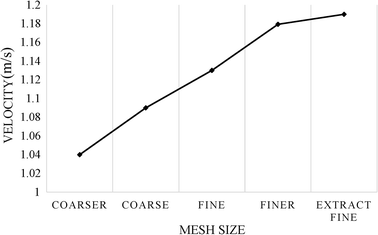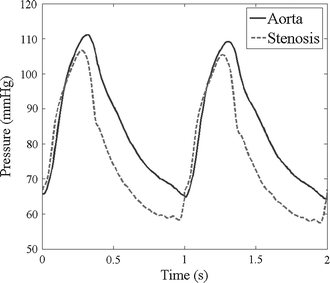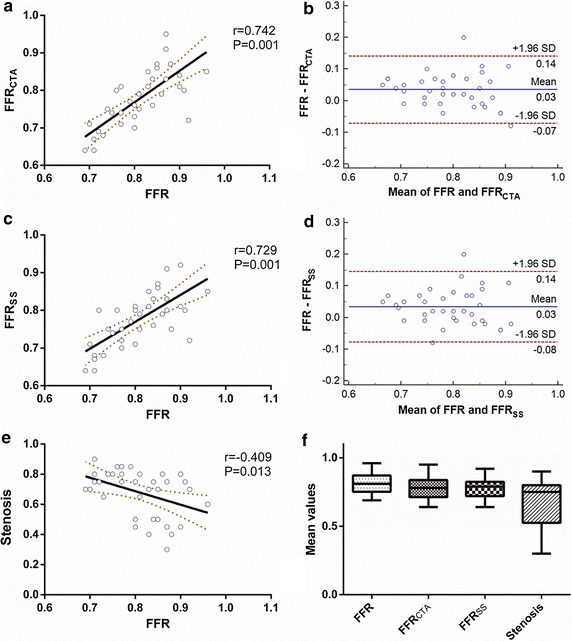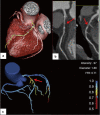A study of noninvasive fractional flow reserve derived from a simplified method based on coronary computed tomography angiography in suspected coronary artery disease
- PMID: 28407768
- PMCID: PMC5391576
- DOI: 10.1186/s12938-017-0330-2
A study of noninvasive fractional flow reserve derived from a simplified method based on coronary computed tomography angiography in suspected coronary artery disease
Abstract
Background: The invasive fractional flow reserve has been considered the gold standard for identifying ischaemia-related stenosis in patients with suspected coronary artery disease. Determining non-invasive FFR based on coronary computed tomographic angiography datasets using computational fluid dynamics tends to be a demanding process. Therefore, the diagnostic performance of a simplified method for the calculation of FFRCTA requires further evaluation.
Objectives: The aim of this study was to investigate the diagnostic performance of FFRCTA calculated based on a simplified method by referring to the invasive FFR in patient-specific coronary arteries and clinical decision-making.
Methods: Twenty-nine subjects included in this study underwent CCTA before undergoing clinically indicated invasive coronary angiography for suspected coronary artery disease. Pulsatile flow simulation and a novel boundary condition were used to obtain FFRCTA based on the CCTA datasets. The Pearson correlation, Bland-Altman plots and the diagnostic performance of FFRCTA and CCTA stenosis were analyzed by comparison to the invasive FFR reference standard. Ischaemia was defined as an FFR or FFRCTA ≤0.80, and anatomically obstructive CAD was defined as a CCTA stenosis >50%.
Results: FFRCTA and invasive FFR were well correlated (r = 0.742, P = 0.001). Slight systematic underestimation was found in FFRCTA (mean difference 0.03, standard deviation 0.05, P = 0.001). The area under the receiver-operating characteristic curve was 0.93 for FFRCTA and 0.75 for CCTA on a per-vessel basis. Per-patient accuracy, sensitivity and specificity were 79.3, 93.7 and 61.5%, respectively, for FFRCTA and 62.1, 87.5 and 30.7%, respectively, for CCTA. Per-vessel accuracy, sensitivity and specificity were 80.6, 94.1 and 68.4%, respectively, for FFRCTA and 61.6, 88.2 and 36.8%, respectively, for CCTA.
Conclusions: FFRCTA derived from pulsatile simulation with a simplified novel boundary condition was in good agreement with invasive FFR and showed better diagnostic performance compared to CCTA, suggesting that the simplified method has the potential to be an alternative and accurate way to assess the haemodynamic characteristics for coronary stenosis.
Keywords: CCTA; CFD; FFR; FFRCTA.
Figures






Similar articles
-
Diagnosis of ischemia-causing coronary stenoses by noninvasive fractional flow reserve computed from coronary computed tomographic angiograms. Results from the prospective multicenter DISCOVER-FLOW (Diagnosis of Ischemia-Causing Stenoses Obtained Via Noninvasive Fractional Flow Reserve) study.J Am Coll Cardiol. 2011 Nov 1;58(19):1989-97. doi: 10.1016/j.jacc.2011.06.066. J Am Coll Cardiol. 2011. PMID: 22032711 Clinical Trial.
-
The impact of image resolution on computation of fractional flow reserve: coronary computed tomography angiography versus 3-dimensional quantitative coronary angiography.Int J Cardiovasc Imaging. 2016 Mar;32(3):513-23. doi: 10.1007/s10554-015-0797-5. Epub 2015 Oct 27. Int J Cardiovasc Imaging. 2016. PMID: 26507326
-
Diagnostic performance of transluminal attenuation gradient and fractional flow reserve by coronary computed tomographic angiography (FFR(CT)) compared to invasive FFR: a sub-group analysis from the DISCOVER-FLOW and DeFACTO studies.Int J Cardiovasc Imaging. 2015 Aug;31(6):1251-9. doi: 10.1007/s10554-015-0666-2. Epub 2015 Apr 24. Int J Cardiovasc Imaging. 2015. PMID: 25904402
-
Computed tomography angiography-derived fractional flow reserve (CT-FFR) for the detection of myocardial ischemia with invasive fractional flow reserve as reference: systematic review and meta-analysis.Eur Radiol. 2020 Feb;30(2):712-725. doi: 10.1007/s00330-019-06470-8. Epub 2019 Nov 6. Eur Radiol. 2020. PMID: 31696294
-
Meta-Analysis of Diagnostic Performance of Coronary Computed Tomography Angiography, Computed Tomography Perfusion, and Computed Tomography-Fractional Flow Reserve in Functional Myocardial Ischemia Assessment Versus Invasive Fractional Flow Reserve.Am J Cardiol. 2015 Nov 1;116(9):1469-78. doi: 10.1016/j.amjcard.2015.07.078. Epub 2015 Aug 14. Am J Cardiol. 2015. PMID: 26347004 Free PMC article. Review.
Cited by
-
Carotid DSA based CFD simulation in assessing the patient with asymptomatic carotid stenosis: a preliminary study.Biomed Eng Online. 2018 Mar 12;17(1):31. doi: 10.1186/s12938-018-0465-9. Biomed Eng Online. 2018. PMID: 29530025 Free PMC article.
-
Comparison of Computed Tomography derived Fractional Flow Reserve to invasive Fractional Flow Reserve in Diagnosis of Functional Coronary Stenosis: A Meta-Analysis.Sci Rep. 2018 Aug 1;8(1):11535. doi: 10.1038/s41598-018-29910-9. Sci Rep. 2018. PMID: 30069020 Free PMC article.
-
Effect of bolus tracking region-of-interest position within the descending aorta on luminal enhancement of coronary arteries in coronary computed tomography angiography.Medicine (Baltimore). 2019 May;98(19):e15538. doi: 10.1097/MD.0000000000015538. Medicine (Baltimore). 2019. PMID: 31083207 Free PMC article.
-
Computational instantaneous wave-free ratio (IFR) for patient-specific coronary artery stenoses using 1D network models.Int J Numer Method Biomed Eng. 2019 Nov;35(11):e3255. doi: 10.1002/cnm.3255. Int J Numer Method Biomed Eng. 2019. PMID: 31469943 Free PMC article.
-
On-site evaluation of CT-based fractional flow reserve using simple boundary conditions for computational fluid dynamics.Int J Cardiovasc Imaging. 2020 Feb;36(2):337-346. doi: 10.1007/s10554-019-01709-3. Epub 2019 Oct 18. Int J Cardiovasc Imaging. 2020. PMID: 31628575
References
-
- Shaw LJ, et al. Optimal medical therapy with or without percutaneous coronary intervention to reduce ischemic burden: results from the Clinical Outcomes Utilizing Revascularization and Aggressive Drug Evaluation (COURAGE) trial nuclear substudy. Circulation. 2008;117(10):1283–1291. doi: 10.1161/CIRCULATIONAHA.107.743963. - DOI - PubMed
MeSH terms
LinkOut - more resources
Full Text Sources
Other Literature Sources
Medical
Miscellaneous

